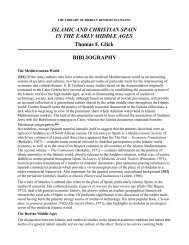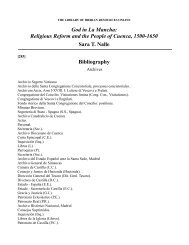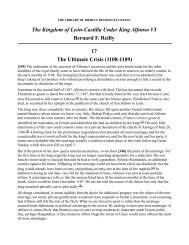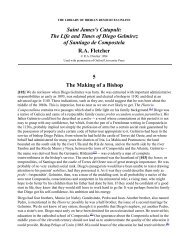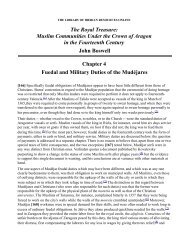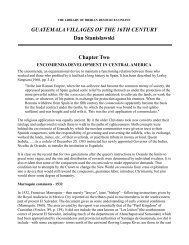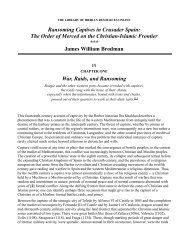The Cluniac Priories of Galicia and Portugal - The Library of Iberian ...
The Cluniac Priories of Galicia and Portugal - The Library of Iberian ...
The Cluniac Priories of Galicia and Portugal - The Library of Iberian ...
Create successful ePaper yourself
Turn your PDF publications into a flip-book with our unique Google optimized e-Paper software.
pervasive influence <strong>of</strong> Cluny in this corner <strong>of</strong> <strong>Galicia</strong>, evident also in the Villafrío <strong>and</strong> Ferreira<br />
donations -- these exhaust the discernible motives other than the usual ones <strong>of</strong> piety. Munio's cession <strong>of</strong><br />
San Pedro de Valverde received prompt papal recognition, for as the obedientia de Valvert it is already<br />
listed among the peninsular priories Honorius II confirmed to Cluny by his bull <strong>of</strong> 2 April 1125 ; (81)<br />
henceforth, for the rest <strong>of</strong> the Middle Ages, it appears regularly among the Luso-Gallegan<br />
dependencies.<br />
8. 26 July 1126: SAN SALVADOR DE BUDIÑO: <strong>Galicia</strong>, dioc. Tuy, prov. Pontevedra, p. j. Tuy, mun.<br />
Porriño, ca. 9 kms. N <strong>of</strong> the city <strong>of</strong> Tuy <strong>and</strong> the Miño, close to its tributary the Louro <strong>and</strong> not far from<br />
the present Portuguese frontier. (82) Ceded by Count Gómez Núñez <strong>and</strong> his brother Fern<strong>and</strong>o, this abbey<br />
had been from its foundation (at an unknown date) in the family <strong>of</strong> the donors; but on the death without<br />
direct heir <strong>of</strong> their uncle, Count Fern<strong>and</strong>o, one-half <strong>of</strong> it had escheated by judicial decision to the<br />
crown. (83) It was after Alfonso VII's restoration <strong>of</strong> this lost portion to Count Gómez in a lost real<br />
privilegio that the two brothers acted to give Cluny the entire monastery, with its ancient coto, <strong>and</strong> all<br />
churches <strong>and</strong> l<strong>and</strong>s within <strong>and</strong> without these limits.<br />
[328] Count Gómez Núñez, the principal agent <strong>of</strong> this extensive grant, since at the time he was in<br />
possession <strong>of</strong> three-quarters <strong>of</strong> San Salvador, is well-known as the count <strong>of</strong> Toroño, a district lying<br />
immediately north <strong>of</strong> Tuy, <strong>and</strong> as principal Gallegan protagonist in the dynastic wars under Urraca. (84)<br />
<strong>The</strong> Historia Compostellana describes him as one "qui fauebat regi puero et rebellabat reginae, potens<br />
situ et munimine castellorum et multitudine equitum atque peditum"; (85) <strong>and</strong> most historians class him<br />
with Count Pedro Froílaz <strong>and</strong> Bishop Diego Gelmírez as a chief <strong>of</strong> the Alfonsoraimundists. (86) But the<br />
diplomatic sources reveal that in fact this mighty lord <strong>of</strong> the Gallegan marchl<strong>and</strong>s <strong>of</strong> the Miño skilfully<br />
maintained ties with the rulers <strong>of</strong> <strong>Portugal</strong> no less than with the partisans <strong>of</strong> young Alfonso, <strong>and</strong> shifted<br />
his allegiance from one side to the other <strong>of</strong> the river as his own interests <strong>and</strong> survival dictated. This<br />
makes it necessary to define narrowly his exact political orientation in July 1126 so as to determine<br />
whether Gómez Núñez' donation <strong>of</strong> Budiño should be linked to Alfonso VII's imperial coronation at<br />
León some five months previous; or whether, in view <strong>of</strong> Queen Teresa's grant <strong>of</strong> Santa María de<br />
Vimieiro the very next year, we are dealing with a concerted Luso-Gallegan Teresist attempt to secure<br />
<strong>Cluniac</strong> support against both the Leonese king-emperor <strong>and</strong> the rising power <strong>of</strong> Alfonso Henriques in<br />
<strong>Portugal</strong>.<br />
<strong>The</strong> first testimony we have to the political oscillations <strong>of</strong> the Count <strong>of</strong> Toroño comes from the<br />
diplomas <strong>of</strong> Count Henry <strong>of</strong> <strong>Portugal</strong> where he appears as a prominent mesnadeiro: in 1110-1111 as<br />
governor <strong>of</strong> the fortress <strong>of</strong> São Cristóvão, near Cerveira, (87) <strong>and</strong> in 1112 as holder <strong>of</strong> the high <strong>of</strong>fice <strong>of</strong><br />
mordomo-mor (maiordomus palatii ipsius comitis). (88) Not long after Henry's death in the latter year<br />
Gómez clearly ab<strong>and</strong>oned Teresa <strong>and</strong> the Portuguese court, for by 1115 he turns up among the select<br />
group <strong>of</strong> leading Gallegan barons whom Diego Gelmírez selected as his sworn defenders in the event<br />
<strong>of</strong> Urraca's [329] violation <strong>of</strong> her latest pact with the Compostelan prelate. (89) In 1116, when Urraca<br />
came to <strong>Galicia</strong> to suppress the Alfonsoraimundists, she launched a major campaign against the Count<br />
<strong>of</strong> Toroño, only to be frustrated by the intervention in his behalf <strong>of</strong> Pedro Froílaz <strong>and</strong> -- significantly --<br />
Queen Teresa <strong>of</strong> <strong>Portugal</strong>. (90) Gómez Núñez participated in the suppression <strong>of</strong> the communal revolt <strong>of</strong><br />
1117 at Compostela; (91) <strong>and</strong> in 1118, when the queen-empress <strong>and</strong> her son's partisans had joined in a<br />
campaign to drive Alfonso <strong>of</strong> Aragón from Castile, he fought in the allied army <strong>and</strong> doubtless<br />
accompanied its victorious march to Toledo, where it acclaimed Alfonso Raimúndez emperor: rex<br />
Hispaniae. (92) But in 1120 a very different picture emerges. In April <strong>of</strong> that year Teresa's diplomas<br />
suddenly begin to carry the subscription <strong>of</strong> Count Gómez, (93) <strong>and</strong> despite his presence at Compostela in<br />
1121, when Gelmírez convoked the oath-takers <strong>of</strong> 1115, (94) his political attachments were clearly with



